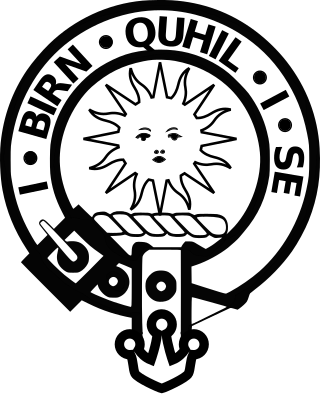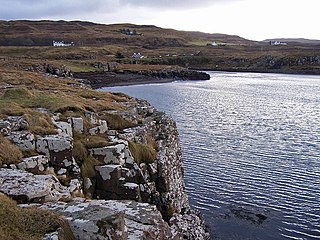
North Uist is an island and community in the Outer Hebrides of Scotland.

Benbecula ( ben-BEK-yuul-ə; Scottish Gaelic: Beinn nam Fadhla or Beinn na Faoghla, according to Scottish Gaelic national poet Alasdair Mac Mhaighstir Alasdair derived from is an island of the Outer Hebrides in the Atlantic Ocean off the west coast of Scotland. In the 2011 census, it had a resident population of 1,283 with a sizable percentage of Roman Catholics. It is in a zone administered by Comhairle nan Eilean Siar or the Western Isles Council. The island is about 12 kilometres from west to east and a similar distance from north to south. It lies between the islands of North Uist and South Uist and is connected to both by road causeways. Benbecula's main settlement and administrative centre is Balivanich.

Clan MacLeod is a Highland Scottish clan associated with the Isle of Skye. There are two main branches of the clan: the MacLeods of Harris and Dunvegan, whose chief is MacLeod of MacLeod, who are known in Gaelic as Sìol Tormoid ; the Clan MacLeod of Lewis and Raasay, whose chief is MacLeod of The Lewes, are known in Gaelic as Sìol Torcaill. Both branches claim descent from Leòd, a Norse-Gael who lived in the 13th century.

Trotternish is the northernmost peninsula of the Isle of Skye in Scotland, beginning at Portree and terminating at Rubha Hunish. The Trotternish escarpment runs almost the full length of the peninsula, some 30 kilometres, and contains such landmarks as the Old Man of Storr and the Quiraing. The summit of The Storr, overlooking the Old Man, is the highest point of the peninsula. The north-eastern part of the peninsula around Quiraing is designated as a National Scenic Area and the entire escarpment is a Special Area of Conservation.

Carinish, is a hamlet on North Uist, in the Outer Hebrides, Scotland. It is in the south of the island, about two miles from the causeway to Benbecula. The hamlet is known for the Carinish Stone Circle and the Trinity Temple. Carinish is within the parish of North Uist and is situated on the A865.

The Fairy Flag is an heirloom of the chiefs of Clan MacLeod. It is held in Dunvegan Castle along with other notable heirlooms, such as the Dunvegan Cup and Sir Rory Mor's Horn. The flag is made of silk, is yellow or brown in colour, and is a square of side about 18 inches. It has been examined numerous times in the last two centuries, and its condition has somewhat deteriorated. It is ripped and tattered, and is considered to be extremely fragile. The flag is covered in small red "elf dots". In the early part of the 19th century, the flag was also marked with small crosses, but these have since disappeared. The silk of the flag has been stated to have originated in the Far East, and was therefore extremely precious, which led some to believe that the flag may have been an important relic of some sort. Others have attempted to associate the flag with the Crusades or even a raven banner, which was said to have been used by various Viking leaders in the British Isles.

Clan Macdonald of Clanranald, also known as Clan Ranald, is a Highland Scottish clan and a branch of Clan Donald, one of the largest Scottish clans. The founder of the Macdonalds of Clanranald is Reginald, 4th great-grandson of Somerled. The Macdonalds of Clanranald descend from Reginald's elder son Allan and the MacDonells of Glengarry descend from his younger son Donald. The clan chief of the MacDonalds of Clanranald is traditionally designated as The Captain of Clanranald and today both the chief and clan are recognised by the Lord Lyon King of Arms, the heraldic judge in Scotland.

Clan Macdonald of Sleat, sometimes known as Clan Donald North and in Gaelic Clann Ùisdein, is a Scottish clan and a branch of Clan Donald—one of the largest Scottish clans. The founder of the Macdonalds of Sleat was Ùisdean, or Hugh, a 6th great-grandson of Somerled, a 12th-century Lord of the Isles. The clan is known in Gaelic as Clann Ùisdein, and its chief's Gaelic designation is Mac Ùisdein, in reference to the clan's founder. Both the clan and its clan chief are recognised by the Lord Lyon King of Arms, who is the heraldic authority in Scotland.

Clan MacDonald of Keppoch, also known as Clan MacDonellof Keppoch or Clan Ranald of Lochaber, is a Highland Scottish clan and a branch of Clan Donald. The progenitor of the clan is Alistair Carrach MacDonald, 4th great-grandson of the warrior Somerled. The clan chief is traditionally designated as the "Son of Ranald's son".

Clan MacLeod of The Lewes, commonly known as Clan MacLeod of Lewis, is a Highland Scottish clan, which at its height held extensive lands in the Western Isles and west coast of Scotland. From the 14th century up until the beginning of the 17th century there were two branches of Macleods: the MacLeods of Dunvegan and Harris ; and the Macleods of the Isle of Lewis. In Gaelic the Macleods of Lewis were known as Sìol Thorcaill, and the MacLeods of Dunvegan and Harris were known as Sìol Thormoid.

The Dunvegan Cup is a wooden ceremonial cup, decorated with silver plates, which dates to 1493. It was created at the request of Caitríona, wife of John Maguire, lord of Fermanagh. The cup is an heirloom of the Macleods of Dunvegan, and is held at their seat of Dunvegan Castle.

The Battle of Coire na Creiche was a Scottish clan battle fought on the Isle of Skye in 1601. It was the culmination of a year of feuding between Clan MacLeod of Dunvegan and the Clan MacDonald of Sleat, that ended with a MacDonald victory in Coire na Creiche on the northern slopes of the Cuillin hills. It was the last clan battle in Skye.

The Battle of the Western Isles was a series of conflicts in 1585 and 1586 on the islands of Jura, Islay, Mull and Tiree, Scotland as well as the peninsula of Kintyre on the mainland. However, although the historic sources describe this as having taken place in the "Western Isles" which are now known as the Outer Hebrides, all of the aforementioned locations are actually in the Inner Hebrides. It was fought between the Clan Macdonald of Sleat and Clan MacDonald of Dunnyveg against the Clan Maclean. In 1585, the Macleans slaughtered a party of the MacDonalds of Sleat when they were mistakenly accused of stealing cattle and the MacDonalds of Sleat and Dunnyveg retaliated. James VI of Scotland intervened but the conflicts continued into 1586. After further intervention an act of Parliament was passed which would levy fines on any clan chiefs who did not maintain peace and good order among their vassals.

Sir Roderick MacLeod of MacLeod, also known as Rory MacLeod, was the 15th Chief of Clan MacLeod and one of the most famed and notorious chiefs of that clan.

Iain Borb MacLeod (1392–1442) is considered to be the sixth chief of Clan MacLeod. He is the first MacLeod chief to which heraldry can be assigned. Clan tradition states that he was a minor at the time of his father's death and for six years an incompetent guardian led the clan to its lowest point in clan history. After reaching the age of maturity, Iain Borb managed to acquire some of the clan's lost lands and led his clan and his kinsmen in the Battle of Harlaw, in 1411. Iain Borb was wounded in the head during the conflict; the wound never completely healed and confined him to his home on Pabbay for much of his life. Tradition states that he died when this wound re-opened during a fencing/wrestling match. There is some disagreement as to which of his sons was the eldest; however, his son William Dubh was the one who finally succeeded to the chiefship, following his death in 1442.

The Battle of Glendale was fought on the Inner Hebridean Isle of Skye, between the MacDonalds of Sleat and the MacDonalds of Clanranald, against the MacLeods of Harris and Dunvegan and the MacLeods of Lewis. According to MacLeod tradition preserved in the early 19th century, the battle was fought in about the year 1490; yet it has been recently suggested that the battle more likely took place sometime after 1513. MacLeod tradition records that the battle was the 'most tremendous battle' that the clan ever fought—although the clan was victorious, it never fully recovered from its severe losses. MacLeod tradition relates how the MacDonalds originally had the upper hand during the conflict, but when the MacLeod's sacred Fairy Flag was unfurled the MacLeods gained heart and won the battle.

Alasdair Crotach MacLeod is considered to be the 8th Chief of Clan MacLeod. He was the son of the 7th Chief of Clan MacLeod, William Dubh, and succeeded his father in 1480, following William Dubh's death at the Battle of Bloody Bay. He was the first MacLeod chief not to be buried on the island of Iona.
Roderick Macleod, also known as Old Rory, was the chief of Clan Macleod of Lewes in the later half of the 16th century.

Teampull na Trionaid is a ruined 13th-century Augustinian nunnery at Carinish, on North Uist, in the Outer Hebrides of Scotland.
Sir Lachlan Mackinnon was chief of the Scottish Highland clan Mackinnon and played a prominent part in the troubled and transitional politics of the West Highlands in the early 17th century.



















